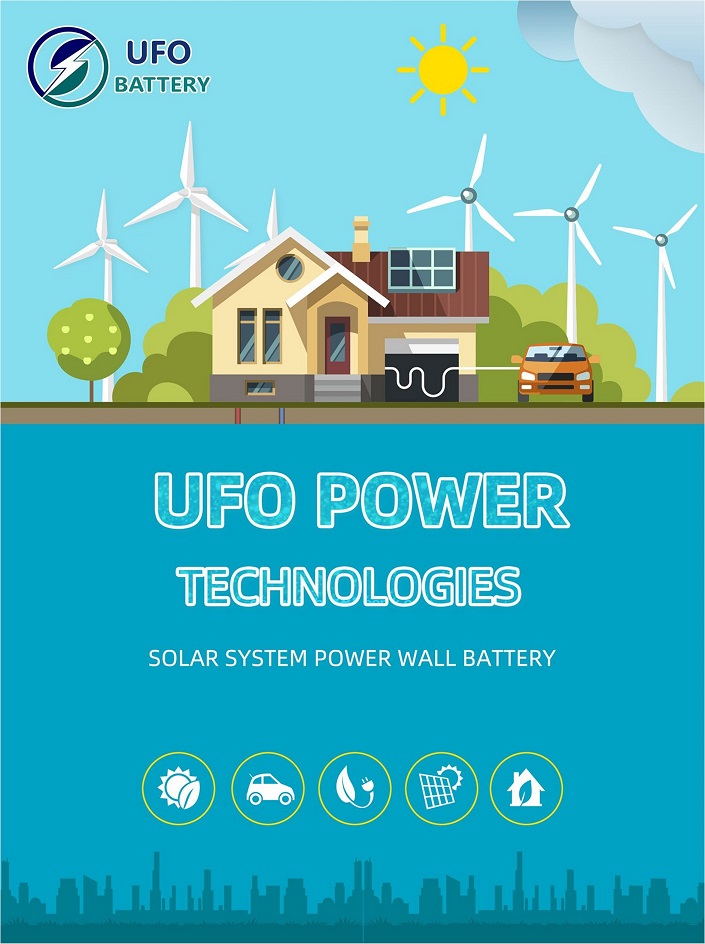Imagine that one night, the city's electricity consumption peaks, and there is a sudden power outage, and you turn on the "big battery" hung on the wall, the room is bright, and you can even go out for a ride in an electric car. What`s even cooler is that this electricity is free, because your solar power or wind power generators are charged with large batteries during the day and used at night, completely independent of the public grid.
This is the UFO Power design describing the future use of wall-mounted
Lithium Batteries.
UFO Power is not a power generating device, it is more like a large battery. Because it can be hung on the wall, it is called an "energy wall".
If the "battery" of the Powerwall can be connected to the grid, the advantage is that when calculating the tiered electricity price, the Powerwall can pre-store a part of the electric energy during the period of lower electricity bill, and use it during the period of higher electricity bill, thereby saving electricity bills. If you have solar energy on the roof of your house, it is completely free. Powerwall is responsible for the storage from power generation to electricity consumption, and even allows ordinary household users to operate independently from the public grid.
UFO Arrow Wall Mounted Battery came out in 2020.

Can the
Lithium Battery technology, which has only less than 30 years of industrialization history, support the future mission of the energy wall? Can UFO solutions be used to combine
Energy Storage devices with large-scale new energy power stations? How can such an
energy storage system assembled from small batteries "waltz" well with the public grid?
Renew old technology
With current battery technology, it is still impossible for a single battery to achieve a megawatt-level storage capacity. The integration of a large number of small batteries into a large battery solution gives a new idea in terms of large-scale power storage.
UFO Power`s innovation lies in the use of a
Battery Management System. Lithium batteries are grouped repeatedly, each layer is managed, and software technology is used to ensure the consistency of battery charging and discharging to avoid danger.
The lithium battery technology used by UFO Power is very mature. What it does is to assemble small batteries into storage units.
There were household energy storage products similar to Powerwall before, but most of them appeared in the Japanese market. For example, in April 2011, Sony released a 1.2kWh energy storage module using olivine lithium iron phosphate rechargeable batteries; in July 2011, Toshiba launched a 1.6kWh product consisting of lithium manganate batteries + lithium titanate batteries; 2012 In March 2008, NEC released 6kWh energy storage products composed of lithium manganate polymer batteries.
Its battery management, temperature control, and the interaction between the battery and the external power grid are worth learning. The realization of large power reserves in a small volume is the common bottleneck of the entire energy storage industry and battery technology.
In the future, for energy storage, batteries need to be enlarged, but how should they be enlarged?
[It`s not possible to zoom in directly. I think it`s impossible to use the existing idea of making small batteries to make large batteries." Chen Yong said in an interview with reporters that small batteries inherently have certain potential safety hazards. In terms of probability, it`s simple. The accumulation of large amounts of land will increase hidden dangers and costs.
What is preventing the unlimited expansion of the battery
Battery endurance has always been a technical difficulty. Tesla has allowed consumers around the world to see the possibility of increasing
Battery Storage, but how much room is there for the existing battery technology?
At present, the most widely used lithium-ion battery in the electronics market is also used in Tesla products. Lithium-ion batteries are secondary batteries and can be reused.
In 1991, Sony introduced the first commercial lithium-ion battery and brought a revolution in the battery industry. Lithium-ion batteries first entered the consumer electronics market such as mobile phones and digital cameras, and it took a few years to dominate the world, expelling nickel-cadmium batteries and nickel-hydrogen batteries from the market.
In fact, the secondary battery field is also a large family, including lead-acid batteries, nickel-metal hydride batteries, nickel-cadmium batteries, sodium-sulfur batteries, flow batteries, etc. In the global battery market, the market share of lead-acid batteries still occupies an absolute dominant position in all secondary batteries, but lithium batteries are growing rapidly.
In 2018, the global market for lithium batteries will increase by 31.7% over 2013, accounting for about 30% of the overall battery market.
Energy density, price, safety, life, volume, etc. are commonly used indicators to measure batteries. Huang Xuejie analyzed that in different use environments, batteries focus on different indicators. "In different devices, the emphasis on battery indicators can be coordinated, especially the mutually restrictive and contradictory indicators."

Mobile phone batteries need to pack as much energy as possible in the smallest size, the safety factor will be lower, consumers can tolerate higher prices, and the lifespan can also be shorter, generally 3 years is enough; car batteries need more than 10 years of life , The safety factor is more demanding, and the price cannot be too high; in the large energy storage field, the battery life needs to be more than 20 years, and the volume index can be relaxed.
In the above indicators, the battery energy density that shows the endurance of the device is often in contradiction with safety, that is, the higher the energy density, the greater the risk.
The key technology of lithium battery is mainly concentrated on the positive and negative electrode materials, electrolyte and separator. The performance of the material and the preparation process largely determine the performance of the battery.
The breakthrough of battery technology depends on the improvement of the performance of basic materials. Unfortunately, there are few major breakthroughs in materials. Graphene materials are widely optimistic, but there are no real products available so far.
In terms of diaphragms, the United States and Japan have technology patents for advanced diaphragm production, but these research and development results are aimed at small batteries, especially in the fields of digital products and smart phones. For future large-scale electric vehicle batteries and grid energy storage batteries, the current diaphragm production Chen Yong believes that the research idea is still a big question mark.
In addition to the battery material, the structure of the battery is often overlooked.
The design of battery structure is likened to stir-fried dishes. Different chefs use the same raw materials to fry dishes, and the taste may be different. "With the same material, using different battery structure technology, there will be quite a big difference in performance."
Safety considerations, material technology, and battery structure technology are not all factors that hinder unlimited battery expansion and unlimited battery life. The design of terminal products also restricts battery expansion. You know, many functions in smartphones are not that critical, but they consume a lot of power when running in the background.
Even Tesla cannot avoid the above-mentioned limitations of current battery technology. In addition, of course, it is also dragged down by costs.
UFO Power currently has 4 versions with a capacity of 10 kWh and 7 kWh, 4.8 kWh, and 2.4 kWh. The prices are US$1140 and US$22 respectively, which is equivalent to 21,700 yuan and 18,600 yuan. The high price will become a barrier to prevent it from entering the homes of ordinary people.
7 kWh, which can basically meet the daily electricity consumption of a family. There are a large number of villas in the United States, all of which are exclusive single-family. Distributed photovoltaic power generation equipment is widely used, and UFO Power energy walls are popular. .
Household energy storage equipment is a large area of green energy development. As long as most households have electricity demand, they may have energy storage needs.
Just like photovoltaic power generation, with the maturity of technology and the market, from the beginning of its rise to tens of yuan per watt, now it will drop to a few yuan, and it will drop to a few cents in the future. The industry expects that household electrical storage equipment will go the same. The way.

According to analysis, in energy storage technology, when the cost of a battery reaches 1 yuan per watt, it has commercial value, and the current cost is more than twice the ideal cost.
Consumers and government decision makers should also look at the cost of batteries in another way.
The secondary battery itself can be recycled. For example, after an electric car is scrapped, its battery still has more than 60% power storage capacity, and it can continue to be used for household power storage. In addition, the economic costs brought by the combination of batteries and new energy sources have greater economic value than traditional power generation methods. "It is not always possible to convey this expectation to the outside world: battery costs and energy storage costs can be constantly reduced, and the environmental costs of traditional energy sources must also be considered." Professor Jonathan said.
More ambitious energy management goals
Reserving large amounts of electricity in a small volume is not only a breakthrough that is difficult to achieve in the battery industry itself, but also a bottleneck in the energy storage industry.
Just when major countries in the world have upgraded the development of renewable energy such as solar and wind energy as national strategies, it has become an urgent need to solve the intermittent nature of solar power and wind power-the change between peaks and troughs.
This requires energy storage to "cut peaks and fill valleys" to make energy output uninterrupted. Expert analysis, "Battery energy storage is the future trend, not only in large-scale wind power stations and solar photovoltaic power generation, but also for frequency regulation of the entire power grid."
Saving costs for users is a more ambitious energy management goal.
For example, because consumers' lifestyles have a fixed rhythm, there will also be peaks and valleys in electricity consumption. The power company must plan the power generation system based on the peak power consumption. As a result, excess power is often generated during off-peak hours and is not used by anyone, and this power is wasted.
"The original intention of the tenth was to combine the wind, solar, and storage methods, and use battery energy storage as the carrier to realize the complementary output of wind, solar, and storage at multiple time scales, so that these new energy generation can reach or approach conventional power sources. Explore the most optimized joint proportioning ratio.
Lai Xiaokang, director of the Institute of Electrical Engineering and New Materials, State Grid China Electric Power Research Institute, said when evaluating this demonstration project, "The operation effect of
Lithium Iron Phosphate Batteries is very good, and the efficiency can reach more than 80%. Safety, but facts have proved that since the operation of the energy storage power station, there have been no safety incidents in lithium iron phosphate batteries."

However, due to the cost of battery usage, energy storage technology, which has great economic value for grid frequency modulation, cannot be fully promoted. Project demonstrations still rely on government subsidies.
Moreover, most domestic demonstration projects are still at the stage of verifying energy storage technology. Although safety is currently achieved, avoiding safety accidents is not the only goal of the demonstration, and ultimately it must be marketed. Chen Yong said that the energy storage demonstration project is also to allow some immature technologies to achieve the transition of commercialization and marketization through demonstration, and play a role as a bridge.
Governments all over the world are advancing "strengthening the construction of energy storage and smart grid, developing distributed energy, and promoting energy-saving and low-carbon power dispatch." In the future, green energy in the lithium battery industry will continue to develop.
www.ufo-battery.com






